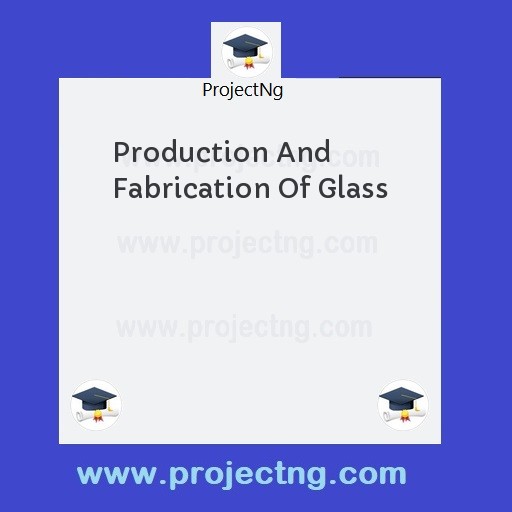Production And Fabrication Of Glass
Seminars Project Topics
Get the Complete Project Materials Now! »
PRODUCTION AND FABRICATION OF GLASS
ABSTRACT
This research work “Production and Fabrication Process of Glass” were carefully carried out. The sole aim of this study is to show the processes are involve in the production of glass which involves two major methods depending on the type of glass product to be produced, the float glass process, which produces sheet glass and the glass blowing method for producing bottles and other containers like jar. However, the two methods (the float and the blowing) are best employed for the production of the two different type of the glass product (sheets and bottle or containers). In the two methods of glass production process, the first process in the glass production is mixing process, melting process, forming process, finishing process, annealing, toughening and laminating, and finally decorating if necessary. Since glass is a very fragile material, it is also recommended that glass product should be handles with care as this will guarantee the safety of the material and the person that is using it.
TABLE OF CONTENTS
Title page i
Letter of transmittal ii
Approval page iii
Dedication iv
Acknowledgement v
Abstract vi
Table of contents vii
Lists of table viii
CHAPTER ONE
1.0 Introduction 1
1.1 Definition
1.2 Brief history of glass 2
1.3 Glass ingredients
CHAPTER TWO
2.0 Literature Review 5
2.1 Production process
2.2 Glass container production (glass blowing)
2.3 Batch processing (Batch house) 6
2.4 The furnace (Hot end) 7
2.5 Forming process 8
2.6 Internal treatment 9
2.7 Annealing 10
2.8 Coating 11
2.9 Cold end 12
2.10 Float glass process 13
2.11 Types of glass, composition and uses 16
2.12 Fused silica glass
2.13 Soda-lime-glass
2.14 Sodium borosilicate glass
2.15 Lead oxide glass 17
2.16 Alumina-silicate-glass
2.17 Oxide glass 18
2.18 Properties of glass 19
2.19 Optical properties
2.20 Electrical properties 20
2.21 Thermal properties
2.22 Chemical properties 21
2.23 Physical properties 22
2.24 Applications of glass
CHAPTER THREE
3.0 Conclusion 25
CHAPTER FOUR
4.0 Recommendation 27
Reference 28
LISTS OF TABLE
Table 1.1 Glass Ingredients 4
Table 2.1 Comparison of types of glasses 18
CHAP TER ONE
1.0 Introduction
1.1 Definition of glass
Glass has been defined and classified in many ways, either based on their composition or on their characteristics. In a familiar usage, the term glass refers to a class of material of great practical importance with a number of very characteristic properties such as transparency, briefness and the properties of softening progressively and continuously when heated. Glass is a compound formed when molten silica is supper cooled to room temperature. It is an organic product of fusion which has cooled to room temperature without crystallization or with no crystals formed. Glass also has been defined as amorphous (non-crystalline) solid materials that are typically brittle and optically transparent. In science, however, the term glass is usually defined in much wider sense, including every one that possesses a non-crystalline (an amorphous) structure that exhibits a glass transition when heated towards the liquid state. In this wider sense, glasses can be made of quite different materials metallically, ionic melts, aqueous solutions, molecular liquids and polymers (Sharma 2008).
1.2 Brief History Glass
The history of glass can be traced back to 3500BCE in Mesopotamia. The term glass developed in the late Roman Empire. It was in the glass making centre at eerier now in modern Germany, that the
Late Latin term glasum originated, probably from a Germanic word for transparent lustrous substances.
1.3 Glass Ingredients
Quartz sand (Silica) is the main raw material in commercial glass production, white fused quartz (primarily composed of Si02) is used for some special applications it is not very common due to its high glass transition temperature of over 1200oC (2192of). Normally, other substances are added to simplify processing. One is sodium carbonate (N02Co3), Which reduces the temperature of fusion of glass. However, the soda makes the glass water soluble, which is usually undesirable, lime (calcium oxide (Cao), generally obtained from limestone), some magnesium oxide (go) and aluminum oxide (Al203) are added to provide for a better chemical durability. The resulting glass contains about 70 to 74% silica by weight and is called soda-lime –glass. Soda lime glass accounts for about 90% of manufactured glass. Most common glass has other ingredients added to change their properties. Lead glass or flint glass is more brilliant because the increased refractive index cause noticeable more specula reflection and increases optical dispersion. Adding barium also increases the refractive index. thorium oxide also increase the refractive index and low dispersion and was formerly used in producing high quality lenses, but due to its radioactivity has been replaced by lanthanum oxide in modern eye glasses. Another common glass ingredient is the “cullet” (recycled glass). The recycled glass saves on raw materials and energy, however, impurities in the cullet can lead to product and equipment failure (Terence 1967).
Table 1.1 Glass Ingredients
The table below shows a summary of the glass ingredients.
|
S/N |
INGREDIENTS |
|
1 |
Quartz sand (silica) |
|
2 |
Fused quartz (SiO2) |
|
3 |
Sodium carbonate (Na2CO3) |
|
4 |
Lime (calcium oxide from Limestone) (CaO) |
|
5 |
Magnesium oxide (MgO) |
|
6 |
Aluminum oxide (Na2O) |
|
7 |
Soda ash (Na2O) |
|
8 |
Cullet (recycled glass) |
Be the First to Share On Social

Enjoying our content?
Don't miss out on new videos! Subscribe to our YouTube channel for more awesome content.
Subscribe Now!













